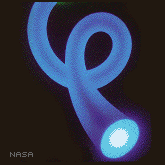Delivered by TIR
 The content of this article has been delivered to you via internet fiber-optic links. Today most phone conversations, fax transmissions and almost all internet and email traffic travel at the speed of light between cities and continents via fiber-optics. An optical fiber (or fiber-optics cable) is to light what a copper wire is to electricity, a guiding medium. In an electrical wire, electrons rush from one end of the wire to the other; driven by the electric field. In optical fiber, photons of light travel from one end to the other purely because they have no choice; they are confined to the cable and can not escape! The phenomenon that is responsible for the confinement of the light signal within the core of the fiber-optic cable is called the Total Internal Reflection or TIR.
The content of this article has been delivered to you via internet fiber-optic links. Today most phone conversations, fax transmissions and almost all internet and email traffic travel at the speed of light between cities and continents via fiber-optics. An optical fiber (or fiber-optics cable) is to light what a copper wire is to electricity, a guiding medium. In an electrical wire, electrons rush from one end of the wire to the other; driven by the electric field. In optical fiber, photons of light travel from one end to the other purely because they have no choice; they are confined to the cable and can not escape! The phenomenon that is responsible for the confinement of the light signal within the core of the fiber-optic cable is called the Total Internal Reflection or TIR.
If you have ever been under water in a swimming pool with your head close to the surface, you have probably noticed that the water-air interface becomes a mirror and you cannot see outside. That is an example of TIR. Basically, whenever you have an interface of two materials (mediums) of different indexes of refraction or optical density, a light beam will fully reflect at this interface if it is trying to escape the denser material at an angle that is larger than a certain critical value.
All optical fibers are basically cylindrical wires made of glass. They have a core (the optically denser medium) and a so-called cladding, which is optically less dense. The cladding fully surrounds the core, like a cylindrical jacket. The light signal is inserted into the core and it travels down the core with occasional TIR reflections from the core-cladding interface. It is almost as if you have a tiny cylindrical mirror from which the light reflects. These total internal reflections are so efficient that the light signal does not lose much of its strength at each reflection as it would when reflecting from an ordinary silver mirror. Thanks to TIR, signals can travel as far as 250 miles (400 km) without needing amplification.
About the Author
Anton Skorucak, MS
 Anton Skorucak is a founder and publisher of ScienceIQ.com. Anton Skorucak has a Master of Science (MS) degree in physics from the University of Southern California, Los Angeles, California and a B.Sc. in physics with a minor in material science from the McMaster University, Canada. He is the president and creator of PhysLink.com, a comprehensive physics and astronomy online education, research and reference web site.
Anton Skorucak is a founder and publisher of ScienceIQ.com. Anton Skorucak has a Master of Science (MS) degree in physics from the University of Southern California, Los Angeles, California and a B.Sc. in physics with a minor in material science from the McMaster University, Canada. He is the president and creator of PhysLink.com, a comprehensive physics and astronomy online education, research and reference web site.


